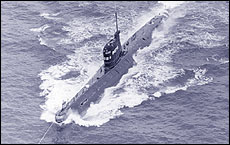
This Soviet Foxtrot-class submarine was photographed by an RNZAF Orion in 1982.

This Soviet Foxtrot-class submarine was photographed by an RNZAF Orion in 1982.
By SCOTT MacLEOD
New Zealand's submarine hunters have rubbished claims by the
Prime Minister that their Orion aircraft have not managed to
find a single target in 35 years.
Former Orion crew members have told the Herald that they
frequently did find submarines - and have pointed to one
well-documented discovery of a Soviet submarine in 1982.
Helen Clark made her comments last Wednesday to justify the
Government's decision not to spend $568 million upgrading
the planes' antiquated radar.
"We would be most unlikely to spend on the
antisubmarine warfare capability," she said.
"We were being asked to spend more than half a billion
dollars to spot vessels which aren't there and haven't been
found to be there in the entire time we've been trying to
spot them."
Yesterday, the former chief of the Whenuapai Orions, Wing
Commander Gordon Ragg, a submarine-hunter from 1977 until
his retirement in 1985, described Helen Clark's comments as
"terribly rude, ignorant, insulting and
incorrect."
He said there was a "well-known route" east of New
Zealand that nuclear submarines used when going to their
stations in the Indian Ocean.
When asked how often our Orions tracked the submarines, he
said there was an occasional flurry of activity, then
nothing for two or three years.
Our allies would tell us the submarines were coming, and the
Orions would target "choke points" to find and
track them. Then we would pass them on to other allies.
"There were all kinds of submarines at times, and we
were quite effective at finding them," said Wing
Commander Ragg.
"At times we found submarines that weren't meant to be
there."
The most clear-cut example occurred on December 22, 1982,
when the RNZAF photographed the Soviet Foxtrot-class
submarine Regul and the research vessel Bashkiriya as they
steamed just west of the Chatham Islands.
Orions had tracked the 2000-tonne diesel-engined Regul for
two months before it entered New Zealand's 320km economic
zone, spotting the submarine near Tahiti and north of the
Cook Islands.
Officially, the Soviets were doing oceanographic research.
But Squadron Leader Tony Medcalf said after his flight that
there was little doubt their work had a military
application.
They could be surveying hiding-places in deep trenches, and
areas where warm and cold water combine to foil the sonar of
submarine-killing ships.
The Herald asked Helen Clark's office why she claimed no
submarines had been spotted for 35 years.
Her spokesmen pointed to extracts from the Maritime Patrol
Review of February 28 and an External Assessment Bureau
report called Submarines in the New Zealand Area.
The review paper said that neither our Navy nor our Air
Force had a proven submarine sighting using sensors for
"several" decades.
The bureau report said that that there had been occasional
sightings of submarines around New Zealand, but none had
been conclusively identified.
The Government last year scrapped the $568 million Project
Sirius, which would have upgraded radar and sensors on our
six Orions.
An RNZN website said there was evidence the French submarine
Rubis supported the agents who bombed the Rainbow Warrior in
the Waitemata Harbour in 1985. More nations than ever before
were buying or building submarines.
The Navy Today magazine listed more than 500 submarines
worldwide, including 200 with Asia/Pacific Navies.